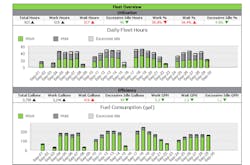Volvo Data Encourages Operator Coaching
Volvo Construction Equipment has built a support system around machine data designed to help customers decipher and use that data to improve efficiency in their fleets. ActiveCare Direct allows the manufacturer to communicate with both the customer and the distributor, and those reports can be used to identify operator behavior that may affect efficiency, operating costs, and even safety.
Other articles about how to use telematics for operator and driver coaching:
- Machine data changes operator behavior
- How to use telematics to reduce insurance costs
- How video, AI improve operator safety
- How to use fault codes to improve operator performance
- Three ways data leads to coaching opportunities
- Set baseline for operator coaching
- Fleets more adept at using machine data
Dave Adams, connectivity services support manager for Volvo, says these reports provide action items that the customer can quickly identify and use to coach operators.
“I’ve seen a total change since we’re pushing only the necessary data to customers rather than them having to log in and decipher all the information,” Adams says. “It’s much easier for them to take action with the data we’re sending them. The actual items that they can take action with...are easy for them to identify.
“By having a report that identifies these items easily, they can quickly turn that item into a training session. They are able to quickly identify where they want to attack, what they want to improve, and make those improvements.” Volvo dealers are also using the reports to identify areas for focus in their own customer training activities, he says.
By using data to identify common behaviors that affect machine performance, coaching can preempt those behaviors from occurring.
Fuel burn is an area where operator coaching has provided immediate savings, Adams says. On average, Volvo has seen customers reduce fuel costs by 10 to 15 percent using machine data, and operator coaching is one way to modify behaviors that waste fuel.
“You have to make sure...when you’re evaluating the report that you’re actually comparing apples to apples,” Adams says. “If you can compare the data across those different platforms, you can quickly identify [which machines are burning more fuel]. The next step is to look at why.... It gives the owner a starting point to...dig deeper and adjust training based on what they find.”
Adams used excavators as an example of how data can determine coaching needs. These machines have different work modes designed to match machine operation to the function it is asked to perform. Some operators use the highest, heaviest work mode thinking it will perform the work more quickly. That work mode, however, may not be needed for a particular job or task. But, Adams says, if the operator is not even trying lower work modes, they’ll never know.
“Our report quickly identifies machines that are working greater than 80 percent of heavy mode,” he says. “[It] will...tell the customer that that operator is not trying other work modes and that there’s a potential for fuel savings there. If you have the same machine doing the same job or similar job, and they’re using a different work mode...you can see the savings right there.”
In a more specific example, Volvo cites Insurance Auto Auctions, Inc. (IAA), which operates approximately 525 wheel loaders across North America. Volvo was able to identify cases of high-speed shifting, an operator action that causes extra wear on a transmission. Gonzalo Quiroz, IAA corporate services manager, estimated that it was doing 10 repair jobs per year at up to $40,000 each. IAA has used machine data to identify and then coach wheel loader operators who use high-speed shifting, suggesting a potential annual savings of $400,000.





